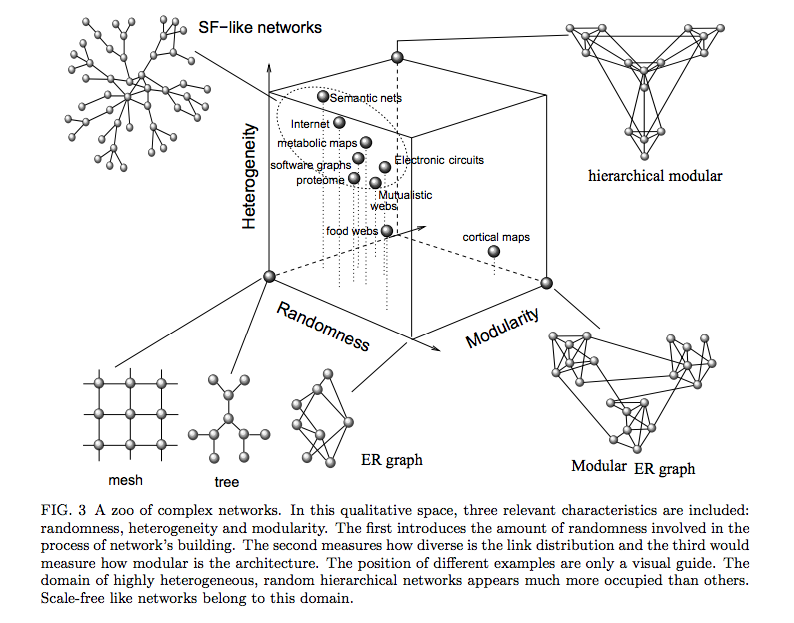Aperçu: G.M.
Au
cours des dernières années, la complexité de la structure du cerveau
chez les sujets sains et avec troubles a été de plus en plus étudiée . Mais les chercheurs ont jusqu'à
présent étudié la complexité structurelle uniquement dans le contexte de
deux réseaux restreints connus sous le nom de réseaux Small-World (SWN) et Scale-free (SFN).

Dans
cette étude, deux mesures générales de la complexité des graphiques, la
complexité de l'indice des graphiques et la complexité offdiagonnelle
sont proposées comme des mesures générales de la complexité, qui ne sont
pas restreintes à SWN uniquement.
Deux
applications sont utilisées pour évaluer l'efficacité des mesures de
complexité: diagnostic de l'autisme et du vieillissement, tous deux
basés sur l'EEG. Il
a été découvert que la complexité de l'indice graphique de la bande
gamma est discriminative pour distinguer les enfants autistes des
enfants non-autistiques. En
outre, la complexité de la bande de theta de la theta chez les sujets
jeunes a été observée comme étant significativement différente des
sujets âgés. Cette
étude montre que les changements dans la structure de la connectivité
fonctionnelle du cerveau dans les troubles et les différents états en
bonne santé peuvent être révélés par des mesures non restreintes de la
complexité du graphique. Bien que les applications présentées dans ce document soient basées
sur EEG, l'approche est générale et peut être utilisée avec d'autres
modalités telles que l'IRMF, le MEG, etc. De plus, elle peut être
utilisée pour étudier tous les autres troubles neurologiques et
psychiatriques.
Neurosci Lett. 2017 Apr 13. pii: S0304-3940(17)30300-2. doi: 10.1016/j.neulet.2017.04.009.
Complexity of Weighted Graph: A New Technique to Investigate Structural Complexity of Brain Activities with Applications to Aging and Autism
Ahmadlou M1, Adeli H2.
Author information
- 1
- Netherlands Institute for Neuroscience, Meibergdreef 47, Amsterdam, Netherlands. Electronic address: mehranahmadlou@gmail.com
- 2
- Departments of Biomedical Engineering, Biomedical Informatics, Civil and Environmental Engineering and Geodetic Science, Electrical and Computer Engineering, Neurology, and Neuroscience, 470 Hitchcock Hall, 2070 Neil Avenue, Ohio State University, Columbus, OH 43210, USA. Electronic address: adeli.1@osu.edu
Abstract
In
recent years complexity of the brain structure in healthy and
disordered subjects has been studied increasingly. But to the best of
the authors' knowledge, researchers so far have investigated the
structural complexity only in the context of two restricted networks
known as Small-World and Scale-free networks; whereas other aspects of
the structural complexity of brain activities may be affected by aging
and neurodegenerative disorders such as the Alzheimer's disease and autism spectrum disorder.
In this study, two general complexity metrics of graphs, Graph Index
Complexity and Offdiagonal Complexity are proposed as general measures
of complexity, not restricted to SWN only. They are adopted to measure
the structural complexity of the weighted graphs instead of the common
binary graphs. Fuzzy Synchronization Likelihood is applied to the EEGs
and their sub-bands, as a functional connectivity metric of the brain,
to construct the functional connectivity graphs. Two applications are
used to evaluate the efficacy of the complexity measures: diagnosis of autism
and aging, both based on EEG. It was discovered that the Graph Index
Complexity of gamma band is discriminative in distinguishing autistic children from non-autistic
children. Also, Offdiagonal Complexity of theta band in young subjects
was observed to be significantly different than old subjects. This study
shows that changes in the structure of functional connectivity of brain
in disorders and different healthy states can be revealed by
unrestricted metrics of graph complexity. While the applications
presented in this paper are based on EEG, the approach is general and
can be used with other modalities such as fMRI, MEG, etc. Further, it
can be used to study every other neurological and psychiatric disorder.
Copyright © 2017 Elsevier B.V. All rights reserved.
- PMID: 28414133
- DOI: 10.1016/j.neulet.2017.04.009